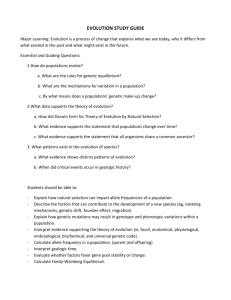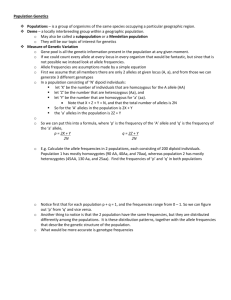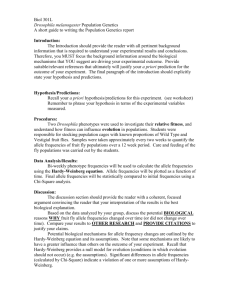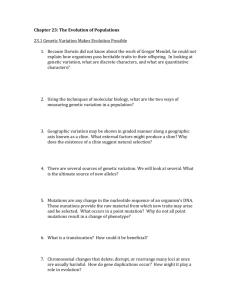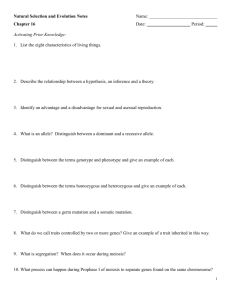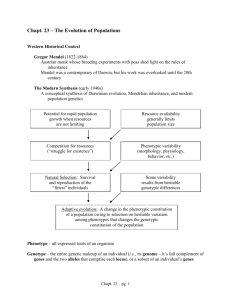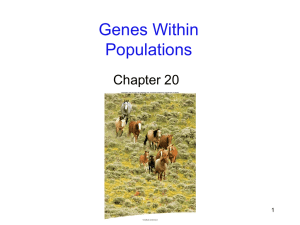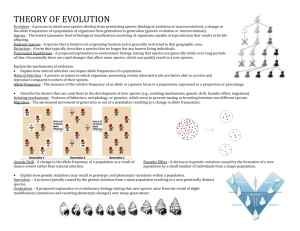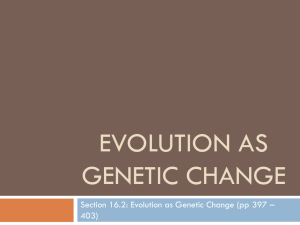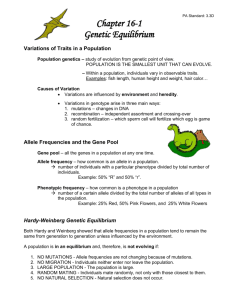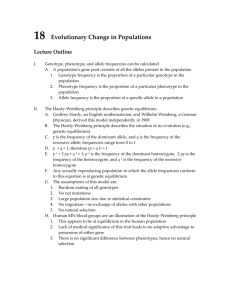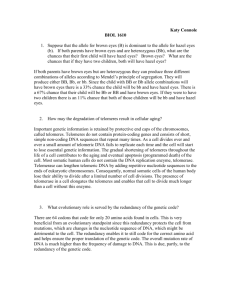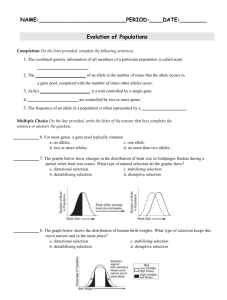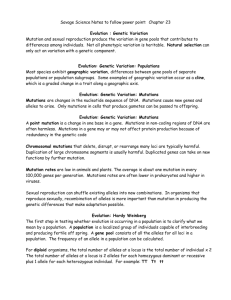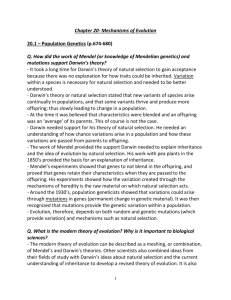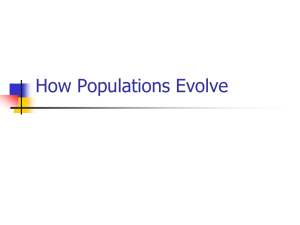Practice Exam- Evolution and Population Genetics
advertisement
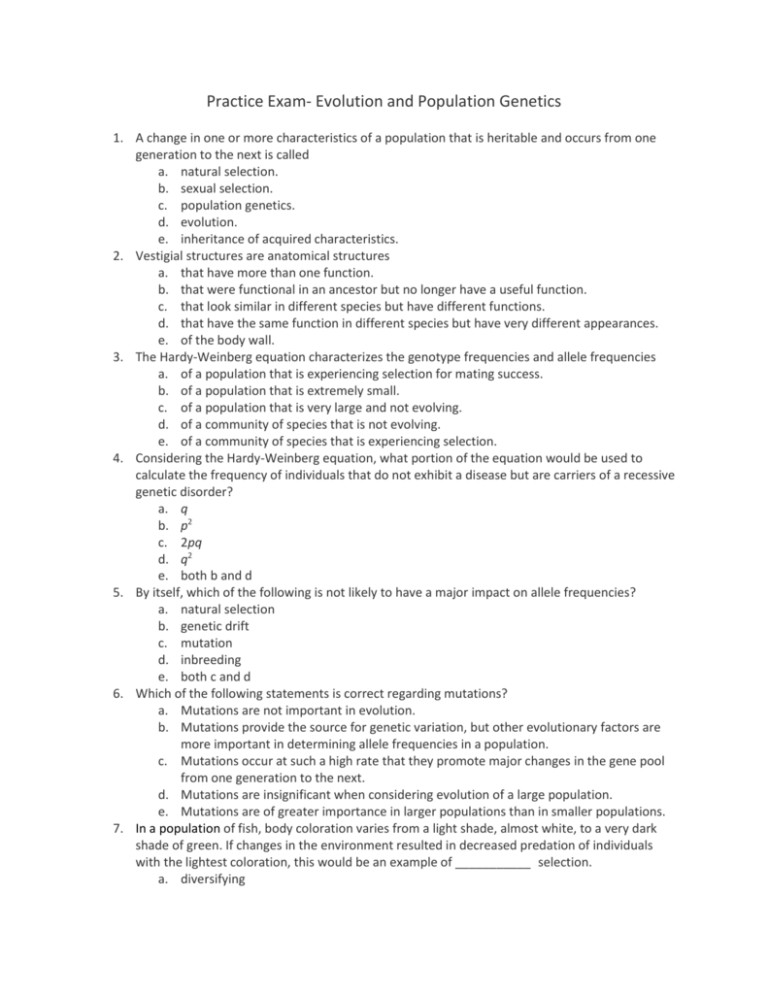
Practice Exam- Evolution and Population Genetics 1. A change in one or more characteristics of a population that is heritable and occurs from one generation to the next is called a. natural selection. b. sexual selection. c. population genetics. d. evolution. e. inheritance of acquired characteristics. 2. Vestigial structures are anatomical structures a. that have more than one function. b. that were functional in an ancestor but no longer have a useful function. c. that look similar in different species but have different functions. d. that have the same function in different species but have very different appearances. e. of the body wall. 3. The Hardy-Weinberg equation characterizes the genotype frequencies and allele frequencies a. of a population that is experiencing selection for mating success. b. of a population that is extremely small. c. of a population that is very large and not evolving. d. of a community of species that is not evolving. e. of a community of species that is experiencing selection. 4. Considering the Hardy-Weinberg equation, what portion of the equation would be used to calculate the frequency of individuals that do not exhibit a disease but are carriers of a recessive genetic disorder? a. q b. p2 c. 2pq d. q2 e. both b and d 5. By itself, which of the following is not likely to have a major impact on allele frequencies? a. natural selection b. genetic drift c. mutation d. inbreeding e. both c and d 6. Which of the following statements is correct regarding mutations? a. Mutations are not important in evolution. b. Mutations provide the source for genetic variation, but other evolutionary factors are more important in determining allele frequencies in a population. c. Mutations occur at such a high rate that they promote major changes in the gene pool from one generation to the next. d. Mutations are insignificant when considering evolution of a large population. e. Mutations are of greater importance in larger populations than in smaller populations. 7. In a population of fish, body coloration varies from a light shade, almost white, to a very dark shade of green. If changes in the environment resulted in decreased predation of individuals with the lightest coloration, this would be an example of ___________ selection. a. diversifying 8. 9. 10. 11. 12. 13. 14. b. stabilizing c. directional d. sexual e. artificial The microevolutionary factor most sensitive to population size and results in changes of allele frequency due to random chance is a. mutation. b. migration. c. selection. d. genetic drift. e. all of the above. There is a large population of wolves with lots of genetic variability which suddenly becomes a small population because humans have taken over their habitat. What is this an example of? a. The founder effect b. Natural selection c. Genetic drift d. Genetic bottleneck e. Evolution The observation that the bone structure found in the flippers of dolphins and whales is similar to that found in a human hand is evidence of a common ancestry based on ____________. a. Homologous structures b. Analogous structures c. Behavior d. Adaptation e. None of the above Comparative molecular biology uses ____________ to identify phylogenetic relationships. a. Carbon dating b. DNA sequences c. Embryological information d. Comparative anatomy of bone structure e. None of the above In a population of wildflowers, the frequency of the allele for red flowers was 0.8. What was the frequency of the white allele, the only other allele for flower color? a. 0.8 b. 0.4 c. 0.6 d. 0.2 e. 0.1 Referring to question 12, what is the frequency of homozygous red flower plants in the population? a. 0.04 b. 0.16 c. 0.32 d. 0.48 e. 0.64 Referring to question 12, what is the frequency of homozygous white flower plants in the population? a. 0.04 15. 16. 17. 18. 19. 20. 21. b. 0.16 c. 0.32 d. 0.48 e. 0.64 Referring to question 12, what is the frequency of plants in the population that are heterozygous for flower color? a. 0.04 b. 0.16 c. 0.32 d. 0.48 e. 0.64 Which one of the following would cause the Hardy-Weinberg principle to be inaccurate? a. The size of the population is very large b. Individuals mate with one another at random c. Natural selection is present d. There is no source of new copies of alleles from outside the population e. None of the above According to data presented regarding evolution, which of the following statements is correct? a. When individuals change in response to challenges from the environment, their altered traits are passed on to offspring. b. Species are created independently of each other and do not change over time. c. Populations- not individuals- change when natural selection occurs. d. The traits of populations become more perfect over time. Why does the presence of extinct forms and transitional features in the fossil record support the pattern component of the theory of evolution by natural selection? a. It supports the hypothesis that individuals change over time b. It supports the hypothesis that weaker species are eliminated by natural selection c. It supports the hypothesis that species evolve to become more complex and better adapted over time d. It supports the hypothesis that species change over time In a population of 2500, how many babies would you expect to have cystic fibrosis, a homozygous recessive condition, if the frequency of the dominant allele is 0.9 and the population is at Hardy-Weinberg equilibrium? a. 0.9 x 2500=2025 b. 2 x 0.9 x 0.1 x 2500= 800 c. 0.9 x 0.1 x 2500= 400 d. 0.1 x 0.1 x 2500= 25 Why are genetic isolation and genetic divergence occurring in apple maggot flies, even though populations occupy the same geographic areas? a. Different populations feed and mate on different types of fruits b. One population is tetraploid; others are diploid c. The introduction of nonnative host plant cause vicariance d. Responses to scents have changed due to disruptive selection The biological species concept can be applied only to which of the following groups? a. Bird species living today b. Dinosaurs and bird species living today c. Dinosaurs d. Bacteria



